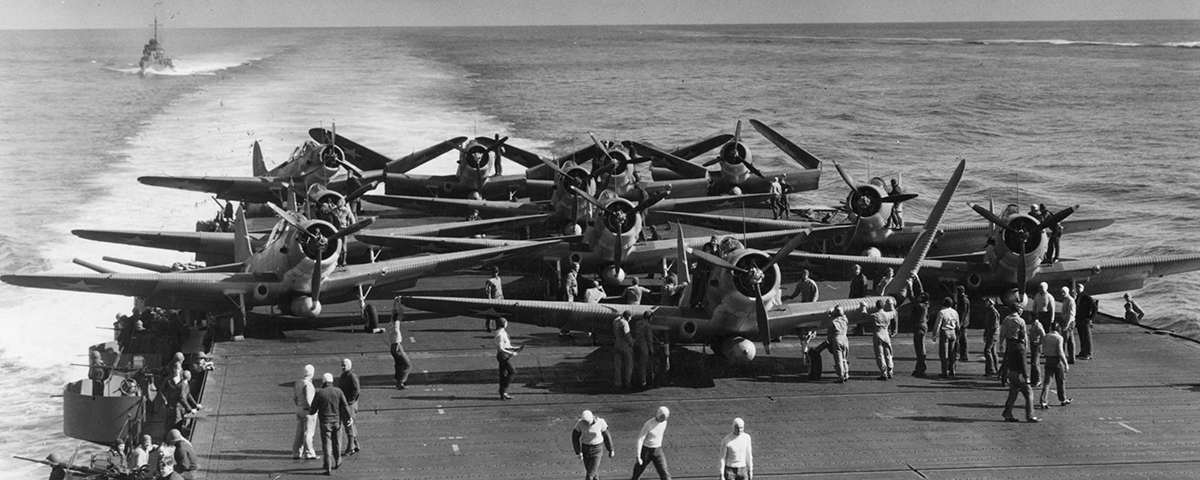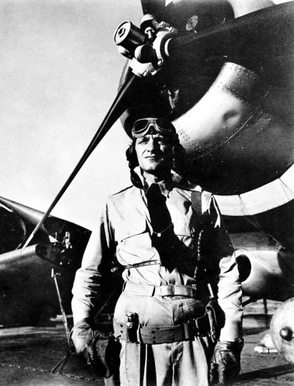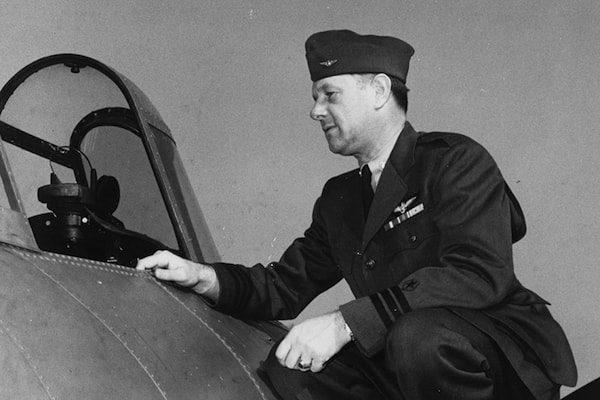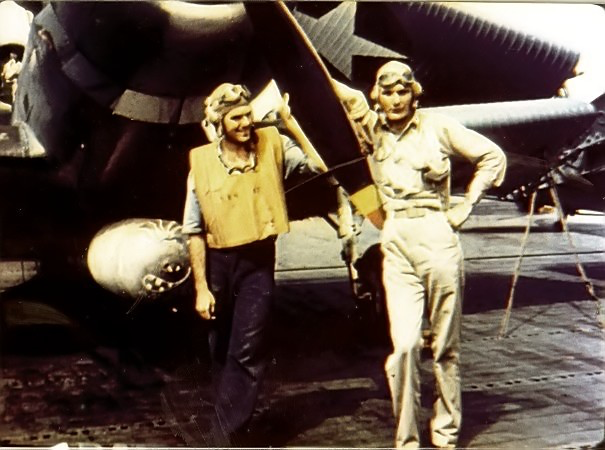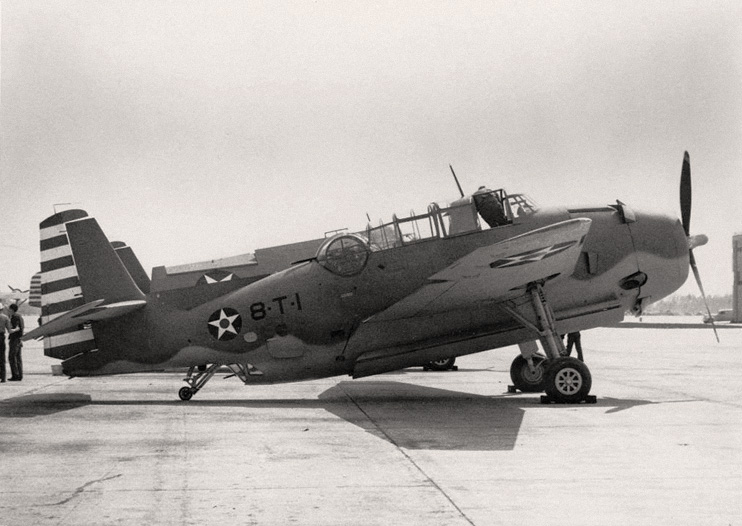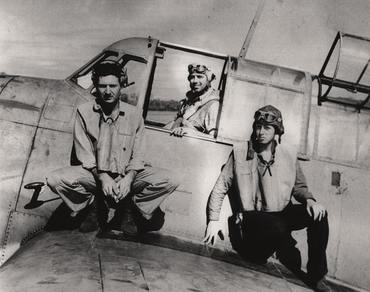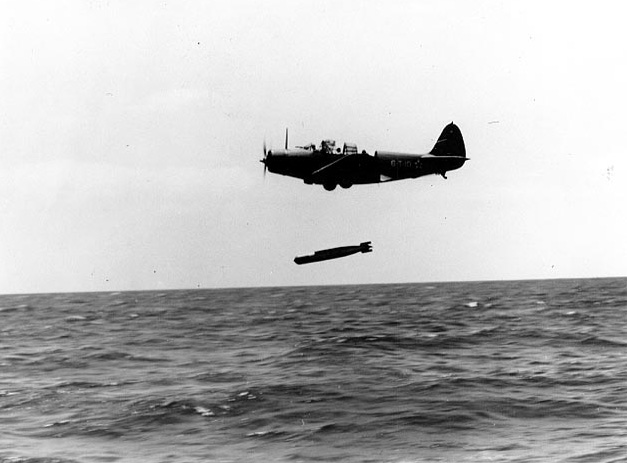76 Years ago - the Battle of Midway began in the Pacific between the US Navy Pacific Fleet and the Kido Butai of the Japanese Empire.
4 June 1942, 0702:
At the Battle of Midway, beginning at 0702, fifteen Douglas TBD-1 Devastator torpedo bombers were launched from the United States Navy aircraft carrier USS Hornet (CV-8) along with squadrons of Douglas SBD Dauntless dive bombers and Grumman F4F Wildcat fighters.
…………………………………………………………………...THE MIRACLE MEN OF MIDWAY (History Net)…………………………………………………………………………...
4 June 1942, 0702:
At the Battle of Midway, beginning at 0702, fifteen Douglas TBD-1 Devastator torpedo bombers were launched from the United States Navy aircraft carrier USS Hornet (CV-8) along with squadrons of Douglas SBD Dauntless dive bombers and Grumman F4F Wildcat fighters.
…………………………………………………………………...THE MIRACLE MEN OF MIDWAY (History Net)…………………………………………………………………………...
|
[More on the VS-6 attack on the Japanese carriers below ]
|
Led by Lieutenant Commander John C. Waldron, Torpedo Squadron Eight (VT-8) flew at low altitude toward the expected position of the attacking Japanese fleet, while the fighters escorted the dive bombers at high altitude. Waldron sighted the enemy fleet at a distance of 30 miles and ordered his squadron to attack. Without any fighter escort, the slow flying torpedo bombers were attacked by Japanese Navy A6M2 Type 0 fighters and defensive anti-aircraft fire from the warships. All fifteen TBDs were shot down.
4 June 1942, 1205:
LCDR C. Wade McClusky led Scouting Six and Bombing Six in an attack resulting in the total destruction of two Japanese carriers: Kaga and Akagi. In the words of Admiral Chester Nimitz, McClusky's decision to continue the search for the enemy and his judgement as to where the enemy might be found, "decided the fate of our carrier task force and our forces at Midway...".
LCDR C. Wade McClusky as commander of Fighting Six, January 1942
My orders were to make a group attack on the enemy striking force. Radio silence was to be maintained until sight contact with the enemy was made. That was the extent of my instructions. The Hornet group was likewise to be launched and, although the Hornet group commander[1] was senior, no command relationship or co-ordination was prescribed. No information was received to indicate how the Yorktown group was to participate. So, with this meager information, we manned our planes.
At 0945, by flashing light signal, I was ordered to "proceed on mission assigned". No information was given as to why the torpedo planes and fighters were delayed. This meant we would be without fighter protection - a serious predicament.
Climbing to gain altitude, I led this small force on a south-westerly course and figured to intercept the enemy at about 1120. At our departure time they were believed to bear about 240 degrees, distance 155 miles and heading toward Midway at 25 knots. Our Task Force was to maintain a course of 240 degrees to close the enemy except when flight operations dictated otherwise.
Arriving at the estimated point of contact the sea was empty. Not a Jap vessel was in sight. A hurried review of my navigation convinced me that I had not erred. What was wrong?
With the clear visibility it was certain that we hadn't passed them unsighted. Allowing for their maximum advance of 25 knots, I was positive they couldn't be in my left semi-circle, that is, between my position and the island of Midway. Then they must be in the right semi-circle, had changed course easterly or westerly, or, most likely reversed course. To allow for a possible westerly change of course, I decided to fly west for 35 miles, then to turn north-west in the precise reverse of the original Japanese course. After making this decision, my next concern was just how far could we go. We had climbed, heavily loaded, to a high altitude. I knew the planes following were probably using more gas than I was. So, with another quick calculation, I decided to stay on course 315 degrees until 1200, then turn north-eastwardly before making a final decision to terminate the hunt and return to the Enterprise.
Call it fate, luck or what you may, because at 1155 I spied a lone Jap cruiser[2] scurrying under full power to the north-east. Concluding that she possibly was a liaison ship between the occupation forces and the striking force, I altered my Group's course to that of the cruiser. At 1205 that decision paid dividends.
Peering through my binoculars which were practically glued to my eyes, I saw dead ahead about 35 miles distant the welcome sight of the Jap carrier striking force. They were in what appeared to be a circular disposition with four carriers in the center, well spaced, and an outer screen of six to eight destroyers and inner support ships composed of two battleships and either four or six cruisers.
I then broke radio silence and reported the contact to Enterprise. Immediately thereafter I gave attack instructions to my group. Figuring that possibly the Hornet Group Commander would make the same decision that I had, it seemed best to concentrate my two squadrons on two carriers. Any greater division of the bomb-load we had might spread out the damage, but I believed would not sink or completely put out of action more than two. Picking the two nearest carriers in the line of approach, I ordered Scouting Six to follow my section in attacking the carrier on the immediate left and Bombing Six to take the right-hand carrier. These two carriers were the largest in the formation and later were determined to be Kaga and Akagi.
As a point for later mention, LT Dick Best, skipper of Bombing Six, radioed that he was having oxygen trouble, had dropped to 15,000 feet and would remain at that altitude to commence the attack. One remarkable fact stood out as we approached the diving point - not a Jap fighter plane was there to molest us. We attributed this to the Japs' fear of the torpedo plane and the defeat they had sustained by that plane in the Coral Sea.
It was 1222 when I started the attack, rolling in a half-roll and coming to a steep 70 degree dive. About halfway down, anti-aircraft fire began booming around us - our approach being a complete surprise up to that point. As we neared the bomb-dropping point, another stroke of luck met our eyes. Both enemy carriers had their decks full of planes which had just returned from the attack on Midway. Later it was learned about the time we had discovered the Jap force, an enemy seaplane had detected our forces. Apparently then, the planes on deck were being refueled and rearmed for an attack on our carriers. Supposing then we, Air Group Six, had turned southward toward Midway, as the Hornet group did, I can still vividly imagine Enterprise and Hornet at the bottom of the sea as the Yorktown was some three days later.
In the meantime, our bombs began to hit home. I leveled off at masthead height, picked the widest opening in their screen and dropped to deck level, figuring any anti-aircraft fire aimed at me would also be aimed at their own ships. All their ships' fire must have been pretty busy because I was well through the screen before I noted bursting shells creeping up behind. With the throttle practically pushed through the instrument panel, I was fortunate in avoiding a contact with death by slight changes of altitude and varying the getaway course to right and left.
It was quick work to figure the return course, and as I raised my head from the plotting board, a stream of tracer bullets started chopping the water around the plane. Almost immediately my gunner, W. G. Chochalousek, in the rear seat, opened fire. Then a Jap Zero zoomed out of range ahead of me. A hurried glance around found another Zero about 1000 feet above, to the left and astern, about to make another attack. Remaining at 20 feet above the water, I waited until the attacking plane was well in his dive, then wrapped my plane in a steep turn toward him. This not only gave him a more difficult deflection shot, but also enabled my gunner to have free room to maneuver his guns. Then ensued about a 5-minute chase, first one Zero attacking from the right, then the second from the left. Each time I would wrap up toward the attacker with Chochalousek keeping up a constant fire. Suddenly a burst from a Jap seemed to envelop the whole plane. The left side of my cockpit was shattered, and I felt my left shoulder had been hit with a sledgehammer. Naturally enough it seemed like the end, we sure were goners. After two or three seconds, I realized there was an unusual quietness except for the purring engine of the old Dauntless. Grasping the intercom phone, I yelled to Chochalousek, but no answer. It was difficult to turn with the pain in my left shoulder and arm, but I finally managed and there was the gunner. facing aft, guns at the ready and unharmed. He had shot down one of the Zeros (probably the one that had got the big burst in on us) and the other decided to call it quits.
We found that our plane had been hit 55 times.
Article provided by Arnold Olson, Public Affairs Officer, USS Enterprise CV-6 Association.
LCDR C. Wade McClusky led Scouting Six and Bombing Six in an attack resulting in the total destruction of two Japanese carriers: Kaga and Akagi. In the words of Admiral Chester Nimitz, McClusky's decision to continue the search for the enemy and his judgement as to where the enemy might be found, "decided the fate of our carrier task force and our forces at Midway...".
LCDR C. Wade McClusky as commander of Fighting Six, January 1942
My orders were to make a group attack on the enemy striking force. Radio silence was to be maintained until sight contact with the enemy was made. That was the extent of my instructions. The Hornet group was likewise to be launched and, although the Hornet group commander[1] was senior, no command relationship or co-ordination was prescribed. No information was received to indicate how the Yorktown group was to participate. So, with this meager information, we manned our planes.
At 0945, by flashing light signal, I was ordered to "proceed on mission assigned". No information was given as to why the torpedo planes and fighters were delayed. This meant we would be without fighter protection - a serious predicament.
Climbing to gain altitude, I led this small force on a south-westerly course and figured to intercept the enemy at about 1120. At our departure time they were believed to bear about 240 degrees, distance 155 miles and heading toward Midway at 25 knots. Our Task Force was to maintain a course of 240 degrees to close the enemy except when flight operations dictated otherwise.
Arriving at the estimated point of contact the sea was empty. Not a Jap vessel was in sight. A hurried review of my navigation convinced me that I had not erred. What was wrong?
With the clear visibility it was certain that we hadn't passed them unsighted. Allowing for their maximum advance of 25 knots, I was positive they couldn't be in my left semi-circle, that is, between my position and the island of Midway. Then they must be in the right semi-circle, had changed course easterly or westerly, or, most likely reversed course. To allow for a possible westerly change of course, I decided to fly west for 35 miles, then to turn north-west in the precise reverse of the original Japanese course. After making this decision, my next concern was just how far could we go. We had climbed, heavily loaded, to a high altitude. I knew the planes following were probably using more gas than I was. So, with another quick calculation, I decided to stay on course 315 degrees until 1200, then turn north-eastwardly before making a final decision to terminate the hunt and return to the Enterprise.
Call it fate, luck or what you may, because at 1155 I spied a lone Jap cruiser[2] scurrying under full power to the north-east. Concluding that she possibly was a liaison ship between the occupation forces and the striking force, I altered my Group's course to that of the cruiser. At 1205 that decision paid dividends.
Peering through my binoculars which were practically glued to my eyes, I saw dead ahead about 35 miles distant the welcome sight of the Jap carrier striking force. They were in what appeared to be a circular disposition with four carriers in the center, well spaced, and an outer screen of six to eight destroyers and inner support ships composed of two battleships and either four or six cruisers.
I then broke radio silence and reported the contact to Enterprise. Immediately thereafter I gave attack instructions to my group. Figuring that possibly the Hornet Group Commander would make the same decision that I had, it seemed best to concentrate my two squadrons on two carriers. Any greater division of the bomb-load we had might spread out the damage, but I believed would not sink or completely put out of action more than two. Picking the two nearest carriers in the line of approach, I ordered Scouting Six to follow my section in attacking the carrier on the immediate left and Bombing Six to take the right-hand carrier. These two carriers were the largest in the formation and later were determined to be Kaga and Akagi.
As a point for later mention, LT Dick Best, skipper of Bombing Six, radioed that he was having oxygen trouble, had dropped to 15,000 feet and would remain at that altitude to commence the attack. One remarkable fact stood out as we approached the diving point - not a Jap fighter plane was there to molest us. We attributed this to the Japs' fear of the torpedo plane and the defeat they had sustained by that plane in the Coral Sea.
It was 1222 when I started the attack, rolling in a half-roll and coming to a steep 70 degree dive. About halfway down, anti-aircraft fire began booming around us - our approach being a complete surprise up to that point. As we neared the bomb-dropping point, another stroke of luck met our eyes. Both enemy carriers had their decks full of planes which had just returned from the attack on Midway. Later it was learned about the time we had discovered the Jap force, an enemy seaplane had detected our forces. Apparently then, the planes on deck were being refueled and rearmed for an attack on our carriers. Supposing then we, Air Group Six, had turned southward toward Midway, as the Hornet group did, I can still vividly imagine Enterprise and Hornet at the bottom of the sea as the Yorktown was some three days later.
In the meantime, our bombs began to hit home. I leveled off at masthead height, picked the widest opening in their screen and dropped to deck level, figuring any anti-aircraft fire aimed at me would also be aimed at their own ships. All their ships' fire must have been pretty busy because I was well through the screen before I noted bursting shells creeping up behind. With the throttle practically pushed through the instrument panel, I was fortunate in avoiding a contact with death by slight changes of altitude and varying the getaway course to right and left.
It was quick work to figure the return course, and as I raised my head from the plotting board, a stream of tracer bullets started chopping the water around the plane. Almost immediately my gunner, W. G. Chochalousek, in the rear seat, opened fire. Then a Jap Zero zoomed out of range ahead of me. A hurried glance around found another Zero about 1000 feet above, to the left and astern, about to make another attack. Remaining at 20 feet above the water, I waited until the attacking plane was well in his dive, then wrapped my plane in a steep turn toward him. This not only gave him a more difficult deflection shot, but also enabled my gunner to have free room to maneuver his guns. Then ensued about a 5-minute chase, first one Zero attacking from the right, then the second from the left. Each time I would wrap up toward the attacker with Chochalousek keeping up a constant fire. Suddenly a burst from a Jap seemed to envelop the whole plane. The left side of my cockpit was shattered, and I felt my left shoulder had been hit with a sledgehammer. Naturally enough it seemed like the end, we sure were goners. After two or three seconds, I realized there was an unusual quietness except for the purring engine of the old Dauntless. Grasping the intercom phone, I yelled to Chochalousek, but no answer. It was difficult to turn with the pain in my left shoulder and arm, but I finally managed and there was the gunner. facing aft, guns at the ready and unharmed. He had shot down one of the Zeros (probably the one that had got the big burst in on us) and the other decided to call it quits.
We found that our plane had been hit 55 times.
Article provided by Arnold Olson, Public Affairs Officer, USS Enterprise CV-6 Association.

